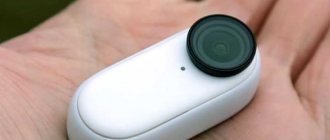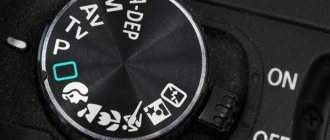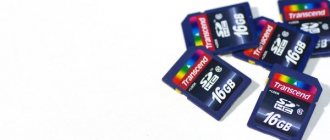| Place | Name | Characteristics in the rating |
| The Best Canon DSLRs for Beginner Photographers |
| 1 | Canon EOS 200D Kit | One of the most compact DSLRs. Balance of cost and capabilities |
| 2 | Canon EOS 80D Kit | The best shooting parameters (25.8 MP matrix) |
| 3 | Canon EOS 1300D Kit | Quick start. Large buffer size in JPEG |
| 4 | Canon EOS 800D Kit | The “golden mean” between the amateur and semi-professional classes. Rotating screen |
| The best Nikon DSLR cameras for beginner photographers |
| 1 | Nikon D5300 Body | The best budget DSLR camera |
| 2 | Nikon D3500 Kit | The best "friendly" camera for a beginner. Powerful battery |
| 3 | Nikon D7200 Body | Time-lapse video function. Magnesium dust and waterproof housing |
| 4 | Nikon D610 Body | Full frame 24 MP sensor. Two slots for SD memory cards |
| The best DSLR cameras from other brands for beginner photographers |
| 1 | Pentax K-70 Kit | Better image clarity. Pixel Shift Resolution Technology |
| 2 | Pentax KP Kit | Thoughtful personalization with interchangeable overlays. High light sensitivity |
| 3 | Sony Alpha ILCA-68 Kit | Best shooting quality |
| The best mirrorless camera for beginner photographers |
| 1 | Sony Alpha ILCE-6000 Kit | 4D autofocus Shooting speed. "Open" mount |
| 2 | Canon EOS M50 Kit | The best set of characteristics. Entry-level mirrorless camera with 4K video recording |
| 3 | Fujifilm X-T100 Kit | Original retro design. Diopter adjustment |
| 4 | Olympus OM-D E-M10 Mark III Kit | Advanced Photo – a block of programs for technically complex photographs |
No. 8 – Panasonic Lumix DC-GX880 Kit
Price: 37,990 rubles
Panasonic Lumix DC-GX880 Kit is the first mirrorless device in the ranking of cameras for beginners and professionals. The model has rich functionality and a wide range of modes, including shooting in RAW format. Manual adjustment of shutter speed and aperture is supported, there are HDMI, USB connectors and a microphone port. You can transfer the footage to your smartphone immediately - all thanks to the presence of Wi-Fi on board the device. When it comes to operating time on a single charge, the camera does not break any records - it is enough for 210 shots, which is the main complaint of the owners, if you look at the reviews.
Panasonic Lumix DC-GX880 Kit
#3 – Fujifilm X-T30 Kit
Price: 99,990 rubles
If you're interested in the best cameras for professional photography, the Fujifilm X-T30 Kit is definitely worth a look. The model has a rich set of interfaces: there are ports for USB, audio, HDMI connector, inputs for microphones and headphones, as well as a special one for connecting a remote control. Another trump card of a professional gadget is fast autofocus. The model has a total of 425 focusing points. Users also praise the capabilities of shooting in RAW, the indestructible body and the abundance of modes.
But many people don’t like the kit lens - it has a meager range of focal lengths (from 15 to 45 mm), as well as low brightness. The main complaint from users is the inconveniently located Q button to call up the quick menu.
Fujifilm X-T30 Kit
How to save money on buying a camera
To save on the purchase of a camera, it is better for a novice photographer to purchase a new camera with a guarantee, but not the latest model range. Previous models have almost the same functionality, the same image quality, but a lower price. Another option is to take an inexpensive camera body and a set of lenses (universal + wide-angle).
Purchasing used devices is inexpensive. However, they already have a certain degree of wear and tear and the associated potential for unpredictable behavior. The same goes for lenses. As a result, the funds saved on the purchase will be used for repairs.
Camera simulator
Virtual simulators or camera simulators are special programs that make life easier for beginners. They allow you to achieve the desired quality of pictures by manually changing the settings of aperture, ISO, and shutter speed. Simulator programs have been developed both for changing the parameters of the camera itself and lenses.
For beginning photographers, such simulators help consolidate theoretical knowledge and understand the dependence of changes in image quality on settings. This is especially important if you only have a point-and-shoot or smartphone at your disposal.
Choosing your first camera - without advertising, brands, pictures and almost no technical details
Traditionally, at the end of the article a final conclusion is made, but, taken out of context, it will not provide useful information and may even be confusing. So, if the result is important, then I don’t recommend going straight to the results.
Passion for photographic equipment is called a rather offensive word, so let’s call such enthusiasts “photogeeks.” A photogeek may or may not be a photographer - these are different hobbies, but sometimes they overlap. Photo geeks often know more about cameras than photographers - their niche in the world of photography is comparable to the niche of overclockers from the world of IT. There are a lot of photo geeks, they cluster on resources dedicated to photographic equipment, and on the same resources, beginners usually ask questions about choosing cameras.
There are a lot of courses and schools for photographers, but there is nothing like this for photo geeks. It would be strange to teach people the ability to assemble one lens out of three or compare matrix parameters, so all photogeeks are self-taught and educate themselves using forums and social networks. The development scenarios are ordinary: a neophyte asks the question “which camera is better?”, voices it on the VKontakte forum, listens to those whom he considers luminaries, then begins to give advice to other neophytes, then it seems to him that he already knows everything (hello, holivars and blog articles), later he realizes that not everything is so simple, and the last three phases are repeated cyclically. The extreme point of exit from the cycle is that he can no longer learn anything new in the communities, and his advice cannot be understood by the majority of other participants, since it contains answers from a higher level of understanding. And there is one less experienced photo geek in the community. As a result, the chances of seeing an answer from a guru to the question “which camera is better?” - very little, you will receive answers from those who do not yet know how much they do not know. It is this category that is the most active, trustworthy and capable of producing tons of similar materials on the topic. I won’t point a finger, but one of these articles prompted me to write my own opus about choosing a camera, and even more about choosing a photo system for an absolute beginner in the matter of photographic equipment. (To avoid misunderstanding: I never became a guru - my self-study, which threatened to drag on for years, unexpectedly ended after a two-hour conversation with two real experts in photography and photographic equipment. I use much of that conversation in the article.)
Today, cheap point-and-shoot cameras are completely killed by mobile phones, and if someone says that he wants to buy a camera, then most often this means that he is not satisfied with the quality of the smartphone’s camera. The requirements are roughly as follows:
- I want bright colors
- Lacks sharpness
- You have to shoot in the dark
- Face against the background of the sun is black
- And so on.
All this is about quality, as reason No. 1. Requirement No. 2 is less common and is expressed by the request “ I want everything to be blurred behind/in front
.” There are other needs, but with very insignificant shares, so I’m omitting them.
Avoiding the holivar, we accept the assumption: smartphones can “sharply, colorfully, in poor lighting conditions and with blur,” but we need a camera that will make it even cooler.
The requirements are clear. To the point. The good news is that choosing a camera is very easy for a neophyte, he is just constantly confused by marketers and armchair analysts. In retaliation, we will immediately limit the choice to a few suitable models using just one parameter. Meet the physical size of the matrix. Or "crop factor". In the wiki about the crop factor, everything is well explained, but in a nutshell, a camera sensor the size of a classic 35mm film frame is crop factor = 1, a sensor half the size is crop factor = 2, etc. On the iPhone 6, for example, the crop factor is 7.21. The lower the number, the cooler the camera. (I specially write everywhere the full name of the parameter “crop factor”, since in the jargon of photo geeks there are also other “crop”.)
The magic of this parameter can be explained simply: at the same stage of technology development, a larger sensor will always outperform a smaller one in image quality. And once again - using the same technologies. And since the technologies of the main manufacturers are really approximately the same, just calculate how much money you have maximum, determine which cameras with the largest matrix size you can afford, and cut off models older than three years.
An important bonus of focusing on a large matrix is the closure of requirement No. 2, which is about “everything is blurry at the back.” The larger the matrix size, the greater the blur. Therefore, we stop taking into account the second requirement in the future - it is fulfilled automatically.
By the words “maximum money” I mean simple calculations taking into account tripods, lenses, bags and whatever else you can think of, namely, how much maximum you can spend at one time on your future photo hobby.
If you think that you are not ready to invest everything at once into an incomprehensible experiment, hold back the amount; if you want to start right away with top equipment, that’s your choice. But with all this money you need to buy one camera, not a backpack of photo junk. Of course, you need some kind of simple “whale” lens, but the prices for them are insignificant enough to be taken into account when choosing. Additional information for beginners about the crop factor:
sellers rarely indicate the crop factor, but you can easily find the size of the matrix in millimeters, and then read the wiki. In total, there are 4 main formats for which smartphones are replaced with cameras:
- 35mm - (full frame, also known as Full Frame or FF) - in the good old days, a full frame digital camera was considered a sign of professionalism or prosperity, but today “people’s FF” have already become available at relatively humane prices.
- 24mm - (in everyday life in the context of cameras it’s simply “crop”, “one-and-a-half crop”) - when you hear something like “amateur DSLR/mirrorless” - that’s what it’s about.
- FT, MFT - (Four Thirds, Micro Four Thirds, in the jargon of “double-crop”) - neither this nor that, but they weigh little.
- “an inch” is almost a “soap box”.
If you're going for something smaller, you might want to leave the smartphone behind.
Let’s look at “megapixel”: this parameter has always caused controversy, but considering it in terms of choosing a camera is simple - you need to choose the one with more pixels. This is a clear sign of more recent technologies (exceptions do happen, but they are specific; you can immediately guess from the inadequate price tag). The number of megapixels affects the choice after taking into account the size of the matrix. For example, you can afford to spend a sum of money, and it fits into a 10 megapixel cropped camera or a 5 megapixel full-frame camera - you need to take the full frame. But if this amount is not enough for the cheapest full-frame camera, then take a crop camera with a large number of megapixels. As a result, you already understand - megapixel does not affect the first rule, but it does fall into the selection criteria.
When studying the assortment of supermarkets, it is easy to notice that some cameras with a smaller matrix are more expensive than cameras with a larger one. The injustice may be due to the strong difference in the age of the models, but most likely it is marketing. The game is based on the fact that in addition to the concept of “quality,” cameras are characterized by a lot of additional goodies, for example:
- Video
- WiFi
- Burst speed
- Panorama
- Automatic Shooting Modes
- Instagram/VKontakte
- Effects
- Touch screen
- And so on.
Now is the time to remind you of something important: we are talking about the quality of photographs, which, as you remember, was the reason for changing your smartphone to a camera.
From this point of view, all of the above had no value until you saw it in the specifications and began to write it down as a plus for some model you liked. Don't do this. In almost any of these parameters, your smartphone will make a professional medium format camera worth a million. Like that:
Video – the presence of a sophisticated video in the camera turns it into a combine harvester. You will need to pay more, and the money will go not to the photo, but to the video. In any case, this is a different direction, and videographers have their own hangouts and problems. One good thing is that no matter what camera you buy with a video recording function on a large matrix, in terms of video quality it will outshine any smartphone along with all recorders, action and web cameras combined.
Wi-Fi - as an Internet connection for uploading pictures to Instagram / VKontakte - is so-so - there is still an interface out of the nightmares of usability experts. And no one takes your smartphone away from you. For transferring files to a computer, the Wi-Fi option can be convenient if there are three photos on the card, but if you are bringing gigabytes from vacation, you will have to wait a very long time. And in general, it’s difficult to find a camera without wi-fi now, so that’s not a criterion.
Burst speed. Question: when you take a photo, is it enough for you to have three more of the same photos, or basically a dozen? Believe me, there will be no difference between 3 frames per second and 10 for a neophyte for a long time. I think that when speed becomes a real problem, he will be able to write such articles himself.
Panorama. The result of very strong in-camera processing. If we are talking about quality, then we need to take several frames and process them on a computer. Software for this activity has been written for every taste, so it won’t take much more time, and the result will be an order of magnitude better, maybe two orders of magnitude.
Automatic Shooting Modes - we can say that there are no cameras without them, and their number is not a reason for concern - if you go towards quality, you will have to understand the exposure settings, these are only three parameters - it is impossible to get confused.
Effects for processing images are now free for any platform, and there is no point in suffering on a small camera screen.
The touch screen looks like a dubious achievement at this stage of development. The closest analogy is typing on a mechanical keyboard and on a mobile phone screen. Once you get used to the buttons on your camera, you will be able to control it without looking up from the viewfinder, but with a touch screen this is not very possible. It’s hard to think of an operation that can be performed faster and more reliably through a touch screen than through buttons, except perhaps selecting an autofocus point, but this is a secondary function.
All of the above and many more of the specifications for the most part are checkers that do not affect the speed, but help to sell. The list of really necessary options (ASM modes, autofocus, exposure metering, continuous shooting, etc.) does not differ from film cameras of the end of the last century - a full set of adjustments will be present.
On the subject of the opus, I cannot ignore shooting in RAW format. This is not a selection criterion - all smart cameras shoot in RAW. But understanding that the quality of photographs and RAW are inseparable can help a beginner take the right direction immediately after purchasing a camera, which will reduce the chances of troubles like: “I bought a carcass for the price of a cast-iron bridge, but the pictures are like from a phone.”
Additional information for beginners about RAW:
RAW is a snapshot file of data from matrix cells. If 5 photons hit the first sensel, it will be written: “first senseel - 5 pieces.” At the same time, it is not even clear what color these photons are (experts, forgive the wild interpretation). Next, a program for developing RAW files is launched on the computer, which knows the structure of your matrix and will compose an image as if from a map, but with a feature - you can greatly influence the color and brightness of groups of pixels, down to individual pixels (read: sections of the image). Something like, “we make it as if not 5 photons, but 50, and not blue, but red, fell into this area.” There is also a computer inside the camera that does the development, but if your *.jpg is drawn in the camera, then this means that the RAW file was developed by an abstract programmer from the camera development team, who, naturally, had no idea about the scene you I just took the photo, and therefore could only do something very average. This is where the pictures come from that look “like they were taken from a mobile phone”, although they were taken with kilo-buck cameras.
From life: A housewife I know takes pictures of her manicure. She has a DSLR, even with some kind of macro attachment, so that her nails could be photographed in the entire frame, but she still took pictures with her smartphone, “because with a DSLR the colors are anything but the same as in reality.” We took a photo of her blue nails (they turned out purple in the photo), after which I opened the RAW file on the laptop, placed a bottle of polish next to it, and with one slider brought out the color to match. The wow effect in all its glory, now my friend only shoots in raw, makes her skin tanned, the highlights on the manicure are brighter, the color of the polish is richer, in general, everything went as it should, subscribers appreciate it. The first moral of this story: you need to shoot in RAW. Second: until the photo has been processed by the author, nothing decent will come of it.
Bonuses of shooting in RAW:
- The accuracy of determining White Balance becomes unimportant. This is when it is not clear whether the dress is blue or white, and the skin in the portraits gives off green. You can easily adjust colors or specify your own.
- You may miss the exposure a little while shooting. If the frame is valuable, but dark/light, then you will have a good chance to fix everything.
- Light and shadow - again using the example of a portrait against the setting sun - you can turn a black spot into a person with a face.
- You will be able to use noise reduction modes as much as necessary, and not see a mess instead of small details.
- You will be able to work in the editor with bitmap image formats.
For all of the above, there are special terms, such as dynamic range, signal-to-noise ratio, etc. I won’t overload the educational program—there are terabytes of materials on the Internet. The purpose of the above is to highlight a simple idea: buying a camera for the sake of quality and not shooting in RAW is bad. But all cameras that are about quality can do RAW, so it’s not a criterion.
An important and worrying moment when choosing, which cannot be ignored, is optics. Interchangeable lenses mean the joy of use, the agony of choice, and a thinning wallet. It is believed that you cannot choose a camera in isolation from the optics, because all this is a Photosystem, so it is always necessary with a capital letter, like: “you need to choose a Photosystem, not a camera.” Yes, this is correct, but it is correct for those who have been photographing for a long time and, I would add, with a certain specialization. Some products are better for landscapes, some are better for underwater photography, some are better for aerial photography, some are better for sports, etc. But for the first camera of a neophyte, this does not matter at all - 99% of the plots can be called without hesitation:
- photos from walks/trips
- photos from drinking sessions
- photos of family, friends and other animals
- I almost forgot - photos of household utensils and Zenit cameras
So, there is a popular wisdom called the “rule of three lenses”, the essence is that it is enough to be able to shoot at three focal lengths - wide, normal, and far.
Believe me, the rule works better than it seems. So a normal person will need a maximum of three prime lenses, and at the apogee - generally only one zoom from start to finish. Of course, no one is stopping you from collecting a collection of a couple of hundred glasses, but for important shootings, when there is no time for experiments, two or three of them will be used. And the main thing in our case is that any popular manufacturer has all the lenses for the main focal lengths, and the arithmetic average in price, quality and convenience will be approximately the same. Bottom line: optics do not affect the choice of the first camera. They often suggest thinking about the future, like “you will begin to develop, choose a system for growth.” If a beginner knew in which direction he would develop, it would help. But, in reality, it is difficult to find a photo geek who has not changed the system. There are a couple of development options for a beginner, the first is that he buys a camera, realizes that photography is not for him, and the camera retires. The second is that he will like it, and over the next few years he will one way or another try other available options. There are photographers (precisely photographers, not photogeeks, these are the ones who can change their entire photographic set twice a week) who switched between systems after several years of their career. Many people have multiple systems. But this is a conscious choice of an experienced person. And getting a beginner to understand what he will need in a year is a dead end. So rely on simple logic - you need to shoot here and now, the details will come out later. That is why I recommended a little higher not to calculate the amount taking into account optics - for a short period of mastering the camera settings, it is enough to have the cheapest system lens, and then both understanding and the next salary will come. The result of the paragraph is another selection criterion - the optics must be replaceable, otherwise the search possibilities for further development become very limited.
Since all leading and not only manufacturers produce models that directly compete with each other, we are forced to further reduce the search range. Using the above criteria, a neophyte will find about 3 options among the more expensive ones, and 6-7 among the cheaper ones. There are three or four price ranges on the market that interest us based on the conditions of choice, and within these ranges it is difficult for even an experienced photo geek to determine the differences in cameras. It is now common for different camera manufacturers to use the same matrix. As a result, all cameras for approximately the same price will differ in characteristics by the size of the measurement error or so. Accordingly - and in terms of image quality too.
At this stage of choosing there are no objective criteria, and the most subjective will help: the feeling of the camera - it should be liked personally by the person who buys it. Otherwise, it will turn out to be an unnecessary thing, no doubt about it. After the choice has been narrowed to three or four models, you need to go to the store and touch all the options with your hands.
And don’t be fooled by the external design in brochures and reviews—tactility is what’s important. One of my disappointments was the much-praised model by its owners, which is all magnesium with inlay and a “masterpiece” button. In the photographs of the product this is exactly what it looks like, but in the store it turned out that it feels like a brick in your hands. I personally didn’t like it, but a crowd of admirers adore this camera, including for its brick-like appearance.
In summary, the algorithm for choosing a camera for a novice photographer (or for a novice photo geek, depending on how it goes): with all the money allocated for the purchase, a camera (and the cheapest possible autofocus lens) is purchased that meets the following criteria, in order of priority:
- The largest matrix
- Interchangeable optics option
- Most megapixels
- I liked it more than others when examined in my hands
Epilogue: photography is a good hobby, perhaps it has the highest simplicity/pleasure ratio, which is indirectly evidenced by its popularity, and hardware is far from the most important thing, so take it easy when choosing a camera, especially the first one.
No. 6 – Sony Alpha ILCE-6000 Kit
Price: 49,990 rubles
If you are still wondering which camera to buy for beginner photographers in 2021, check out the Sony Alpha ILCE-6000 Kit. This is a high-quality mirrorless camera from a Japanese company with miniature dimensions. Due to the latter, the model is perfect for those who travel a lot. The camera has Wi-Fi and NFC, so you can control it from your phone, and instantly transfer captured photos to your smartphone.
Among other features of the device, the owners in the reviews mention a small amount of noise at any ISO, which, together with an advanced matrix, allows you to achieve high-quality results when shooting at night, fast autofocus and a well-thought-out design with the ability to flexibly configure programmable buttons. The exception is that the location of the video recording key is not the best. Another controversial point is that the colors on the display look a little colder than they actually are.
Sony Alpha ILCE-6000 Kit
#9 – Canon EOS 650D Kit
Price: 21,290 rubles
Trying to determine which camera is best to buy for high-quality photos, we couldn’t pass up the Canon EOS 650D Kit. This is a miniature and compact solution with a convenient touch screen and touch focusing. The model, popular in Russia, is well suited for shooting landscapes due to its rotating screen, and a full battery charge is enough to take 1000 shots.
Basic focal lengths for a budget device are excellent. Better than competitors at a similar price. Amateurs will also like the model due to adequate automatic modes, allowing even novice photographers to get a high-quality shot. In reviews, buyers complain about slow focusing when shooting video and a weak microphone. To record sound, it is better to connect an external accessory. Nevertheless, in terms of price-quality ratio, this is an extremely advantageous offer.
Canon EOS 650D Kit











